torque CHEVROLET BLAZER 2004 2.G Owners Manual
[x] Cancel search | Manufacturer: CHEVROLET, Model Year: 2004, Model line: BLAZER, Model: CHEVROLET BLAZER 2004 2.GPages: 446, PDF Size: 2.93 MB
Page 97 of 446
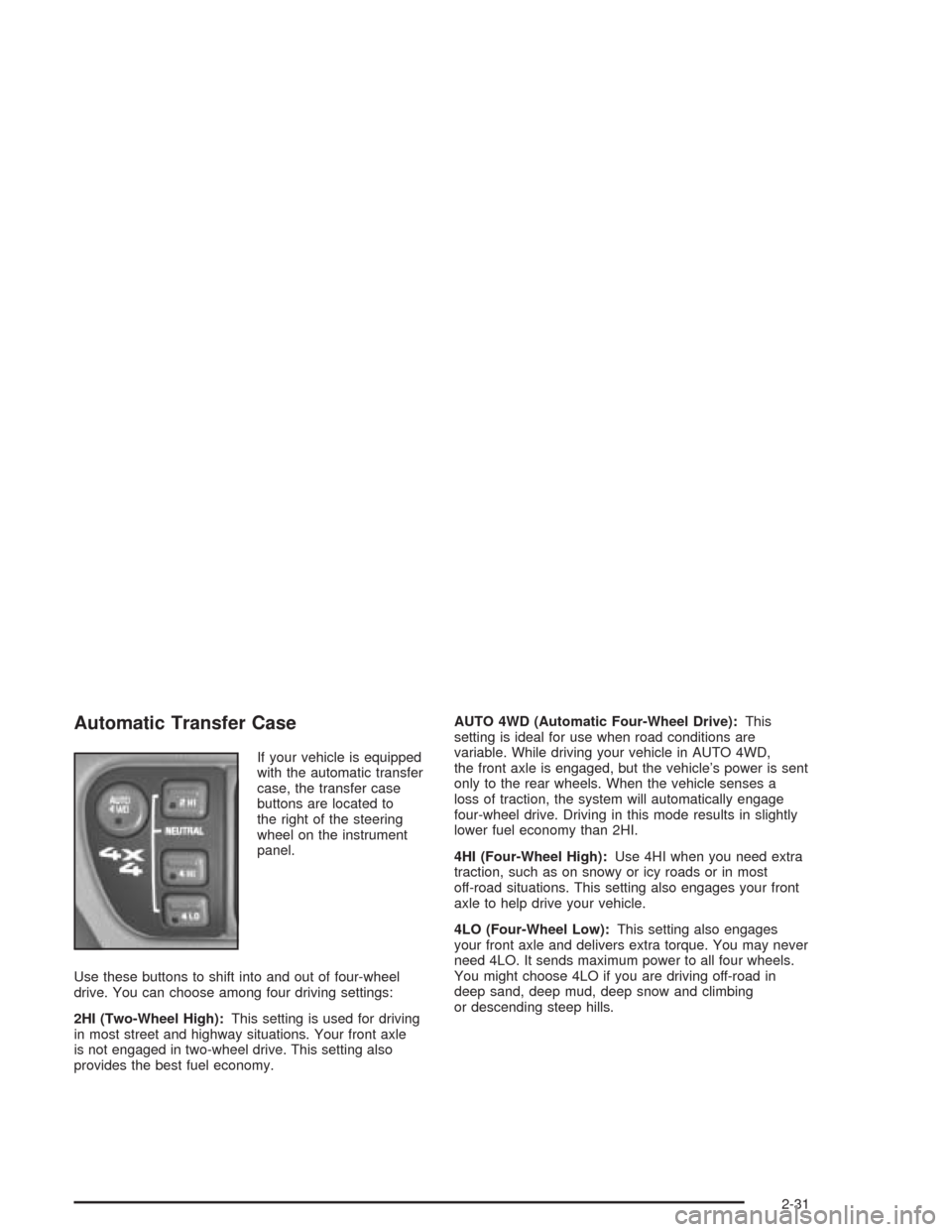
Automatic Transfer Case
If your vehicle is equipped
with the automatic transfer
case, the transfer case
buttons are located to
the right of the steering
wheel on the instrument
panel.
Use these buttons to shift into and out of four-wheel
drive. You can choose among four driving settings:
2HI (Two-Wheel High):This setting is used for driving
in most street and highway situations. Your front axle
is not engaged in two-wheel drive. This setting also
provides the best fuel economy.AUTO 4WD (Automatic Four-Wheel Drive):This
setting is ideal for use when road conditions are
variable. While driving your vehicle in AUTO 4WD,
the front axle is engaged, but the vehicle’s power is sent
only to the rear wheels. When the vehicle senses a
loss of traction, the system will automatically engage
four-wheel drive. Driving in this mode results in slightly
lower fuel economy than 2HI.
4HI (Four-Wheel High):Use 4HI when you need extra
traction, such as on snowy or icy roads or in most
off-road situations. This setting also engages your front
axle to help drive your vehicle.
4LO (Four-Wheel Low):This setting also engages
your front axle and delivers extra torque. You may never
need 4LO. It sends maximum power to all four wheels.
You might choose 4LO if you are driving off-road in
deep sand, deep mud, deep snow and climbing
or descending steep hills.
2-31
Page 104 of 446
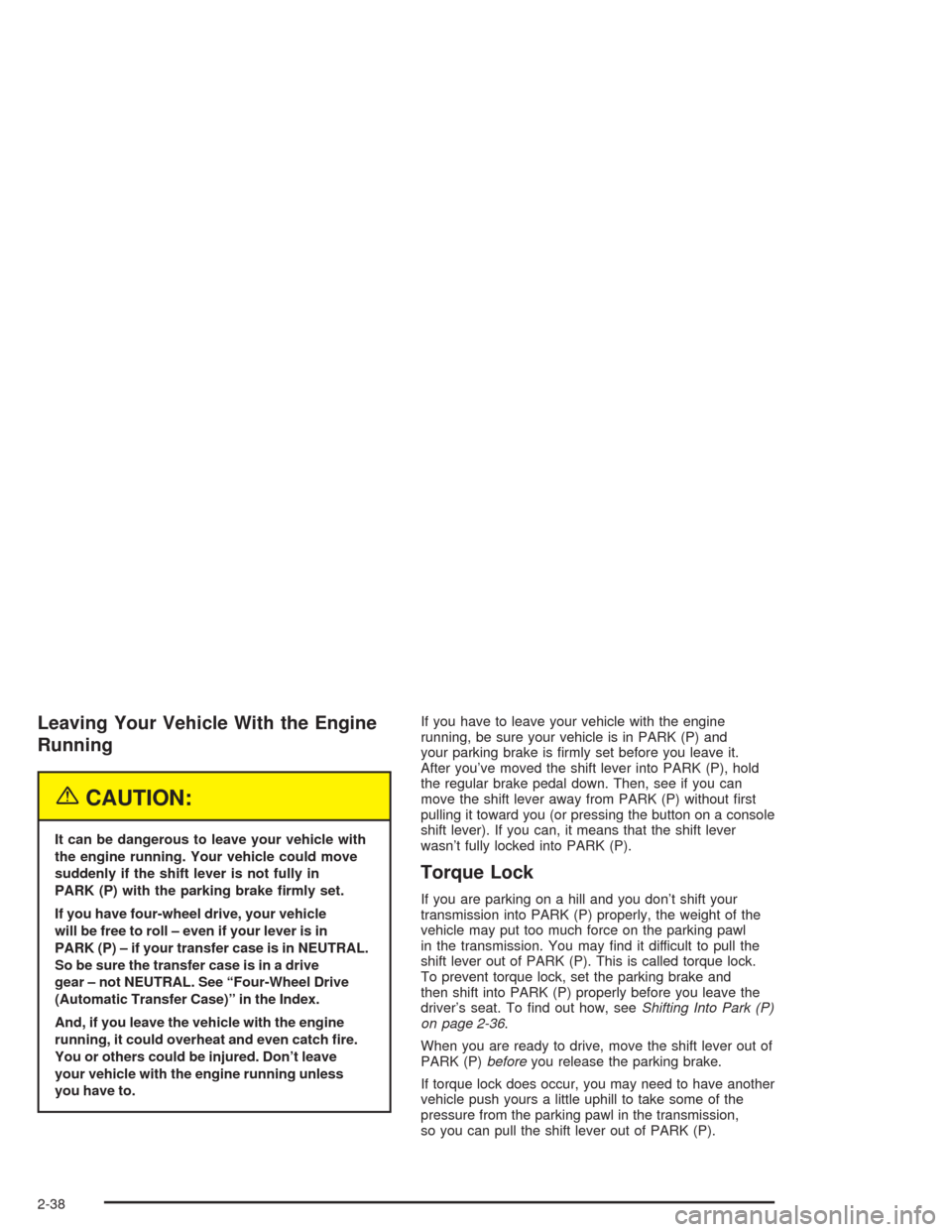
Leaving Your Vehicle With the Engine
Running
{CAUTION:
It can be dangerous to leave your vehicle with
the engine running. Your vehicle could move
suddenly if the shift lever is not fully in
PARK (P) with the parking brake �rmly set.
If you have four-wheel drive, your vehicle
will be free to roll – even if your lever is in
PARK (P) – if your transfer case is in NEUTRAL.
So be sure the transfer case is in a drive
gear – not NEUTRAL. See “Four-Wheel Drive
(Automatic Transfer Case)” in the Index.
And, if you leave the vehicle with the engine
running, it could overheat and even catch �re.
You or others could be injured. Don’t leave
your vehicle with the engine running unless
you have to.If you have to leave your vehicle with the engine
running, be sure your vehicle is in PARK (P) and
your parking brake is �rmly set before you leave it.
After you’ve moved the shift lever into PARK (P), hold
the regular brake pedal down. Then, see if you can
move the shift lever away from PARK (P) without �rst
pulling it toward you (or pressing the button on a console
shift lever). If you can, it means that the shift lever
wasn’t fully locked into PARK (P).
Torque Lock
If you are parking on a hill and you don’t shift your
transmission into PARK (P) properly, the weight of the
vehicle may put too much force on the parking pawl
in the transmission. You may �nd it difficult to pull the
shift lever out of PARK (P). This is called torque lock.
To prevent torque lock, set the parking brake and
then shift into PARK (P) properly before you leave the
driver’s seat. To �nd out how, seeShifting Into Park (P)
on page 2-36.
When you are ready to drive, move the shift lever out of
PARK (P)beforeyou release the parking brake.
If torque lock does occur, you may need to have another
vehicle push yours a little uphill to take some of the
pressure from the parking pawl in the transmission,
so you can pull the shift lever out of PARK (P).
2-38
Page 317 of 446
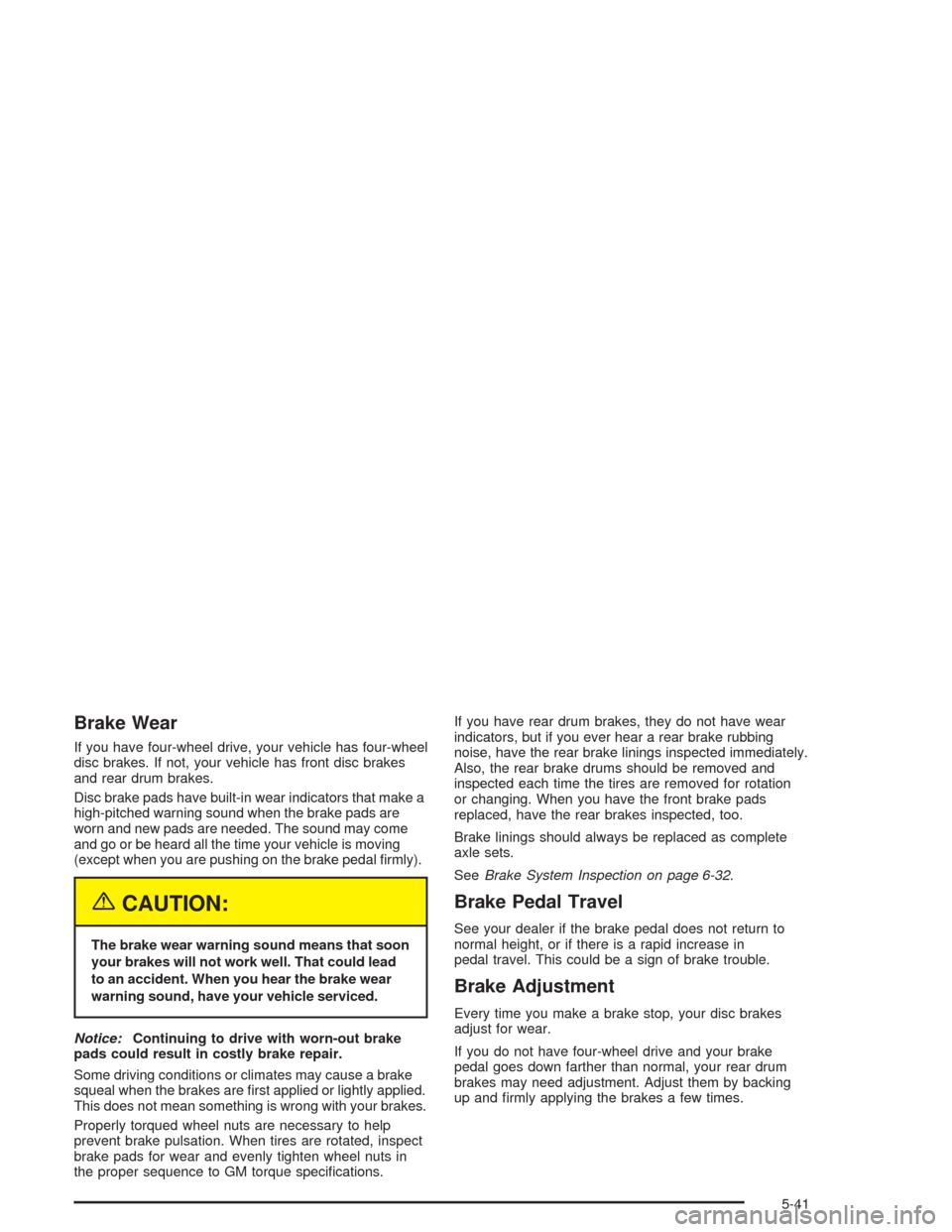
Brake Wear
If you have four-wheel drive, your vehicle has four-wheel
disc brakes. If not, your vehicle has front disc brakes
and rear drum brakes.
Disc brake pads have built-in wear indicators that make a
high-pitched warning sound when the brake pads are
worn and new pads are needed. The sound may come
and go or be heard all the time your vehicle is moving
(except when you are pushing on the brake pedal �rmly).
{CAUTION:
The brake wear warning sound means that soon
your brakes will not work well. That could lead
to an accident. When you hear the brake wear
warning sound, have your vehicle serviced.
Notice:Continuing to drive with worn-out brake
pads could result in costly brake repair.
Some driving conditions or climates may cause a brake
squeal when the brakes are �rst applied or lightly applied.
This does not mean something is wrong with your brakes.
Properly torqued wheel nuts are necessary to help
prevent brake pulsation. When tires are rotated, inspect
brake pads for wear and evenly tighten wheel nuts in
the proper sequence to GM torque speci�cations.If you have rear drum brakes, they do not have wear
indicators, but if you ever hear a rear brake rubbing
noise, have the rear brake linings inspected immediately.
Also, the rear brake drums should be removed and
inspected each time the tires are removed for rotation
or changing. When you have the front brake pads
replaced, have the rear brakes inspected, too.
Brake linings should always be replaced as complete
axle sets.
SeeBrake System Inspection on page 6-32.
Brake Pedal Travel
See your dealer if the brake pedal does not return to
normal height, or if there is a rapid increase in
pedal travel. This could be a sign of brake trouble.
Brake Adjustment
Every time you make a brake stop, your disc brakes
adjust for wear.
If you do not have four-wheel drive and your brake
pedal goes down farther than normal, your rear drum
brakes may need adjustment. Adjust them by backing
up and �rmly applying the brakes a few times.
5-41
Page 345 of 446
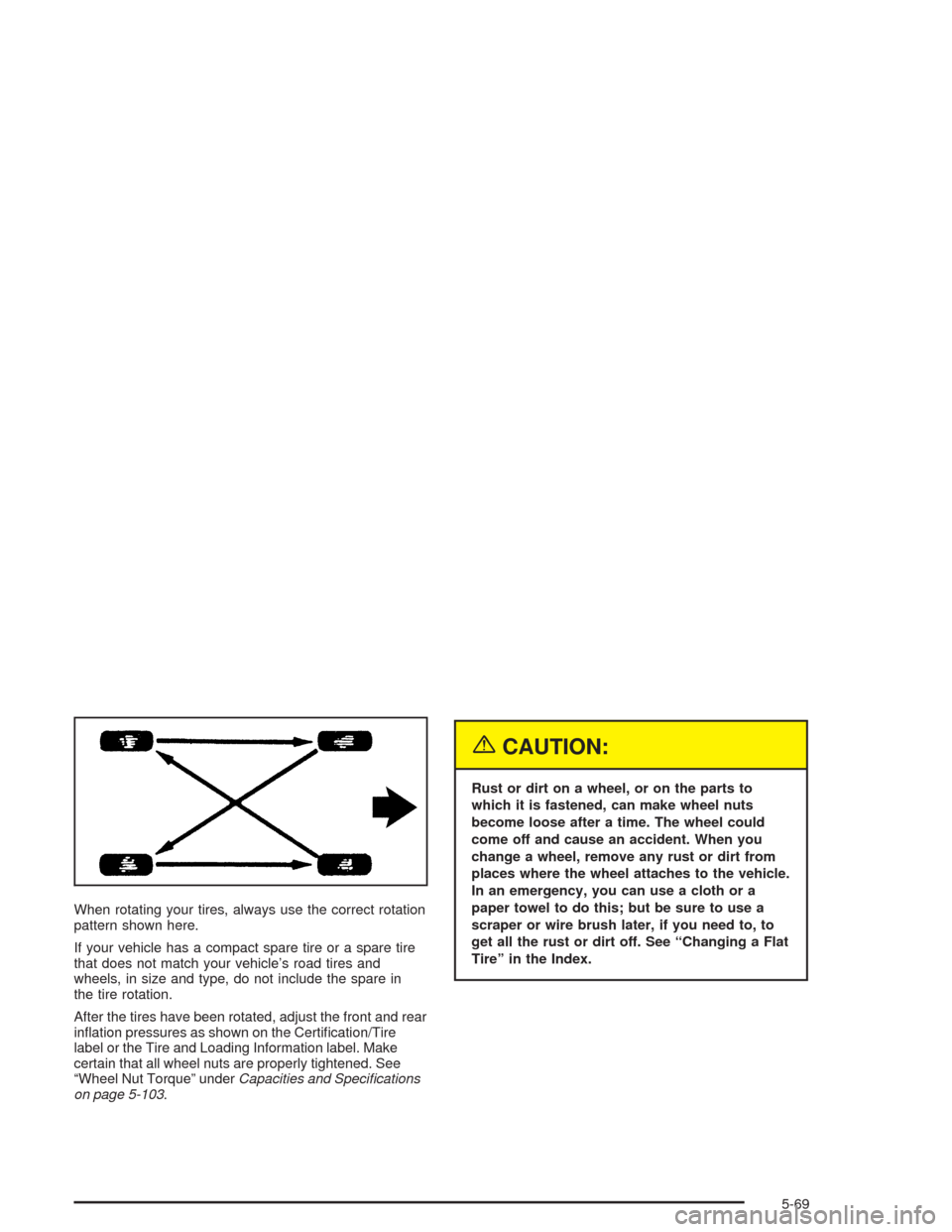
When rotating your tires, always use the correct rotation
pattern shown here.
If your vehicle has a compact spare tire or a spare tire
that does not match your vehicle’s road tires and
wheels, in size and type, do not include the spare in
the tire rotation.
After the tires have been rotated, adjust the front and rear
in�ation pressures as shown on the Certi�cation/Tire
label or the Tire and Loading Information label. Make
certain that all wheel nuts are properly tightened. See
“Wheel Nut Torque” underCapacities and Speci�cations
on page 5-103.
{CAUTION:
Rust or dirt on a wheel, or on the parts to
which it is fastened, can make wheel nuts
become loose after a time. The wheel could
come off and cause an accident. When you
change a wheel, remove any rust or dirt from
places where the wheel attaches to the vehicle.
In an emergency, you can use a cloth or a
paper towel to do this; but be sure to use a
scraper or wire brush later, if you need to, to
get all the rust or dirt off. See “Changing a Flat
Tire” in the Index.
5-69
Page 360 of 446
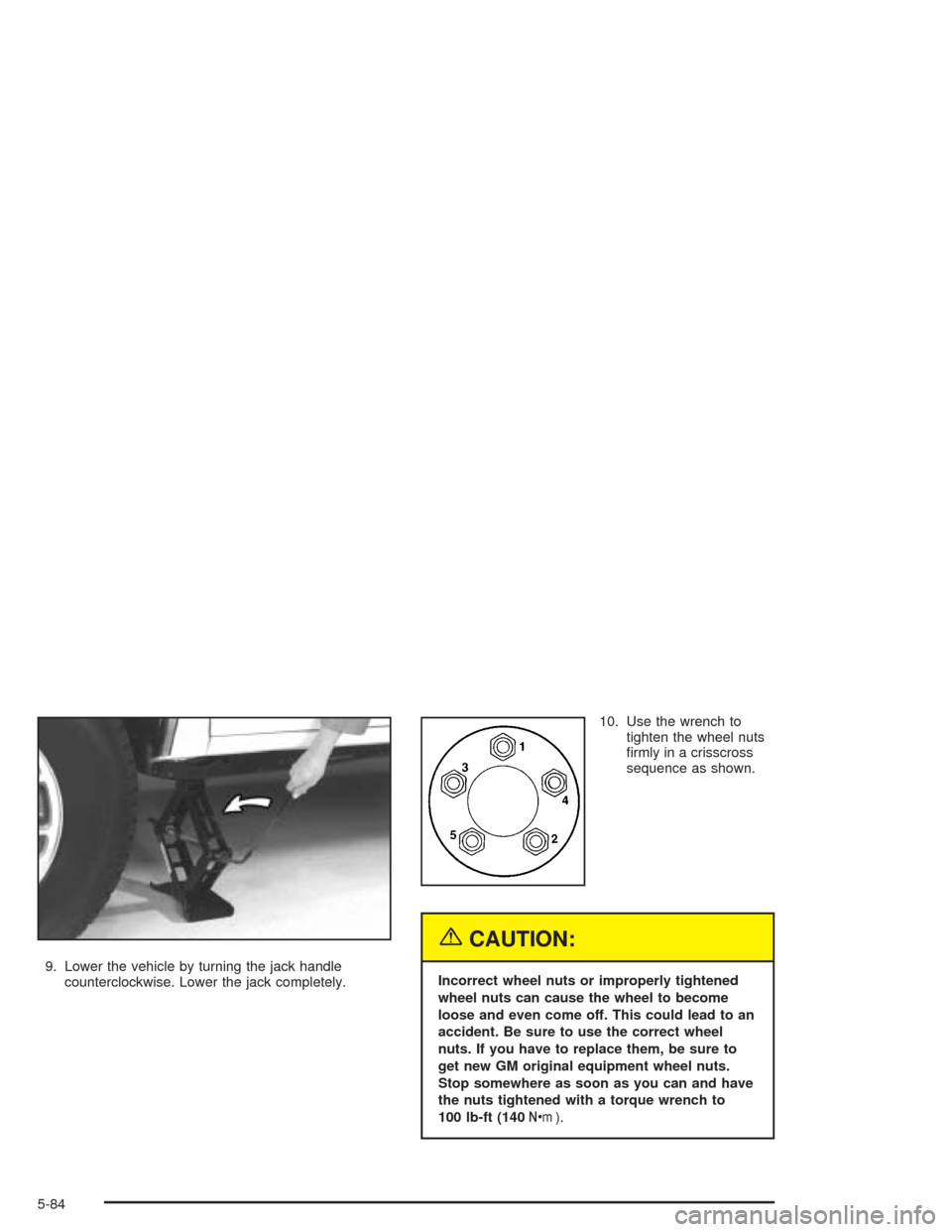
9. Lower the vehicle by turning the jack handle
counterclockwise. Lower the jack completely.10. Use the wrench to
tighten the wheel nuts
�rmly in a crisscross
sequence as shown.
{CAUTION:
Incorrect wheel nuts or improperly tightened
wheel nuts can cause the wheel to become
loose and even come off. This could lead to an
accident. Be sure to use the correct wheel
nuts. If you have to replace them, be sure to
get new GM original equipment wheel nuts.
Stop somewhere as soon as you can and have
the nuts tightened with a torque wrench to
100 lb-ft (140Y).
5-84
Page 361 of 446
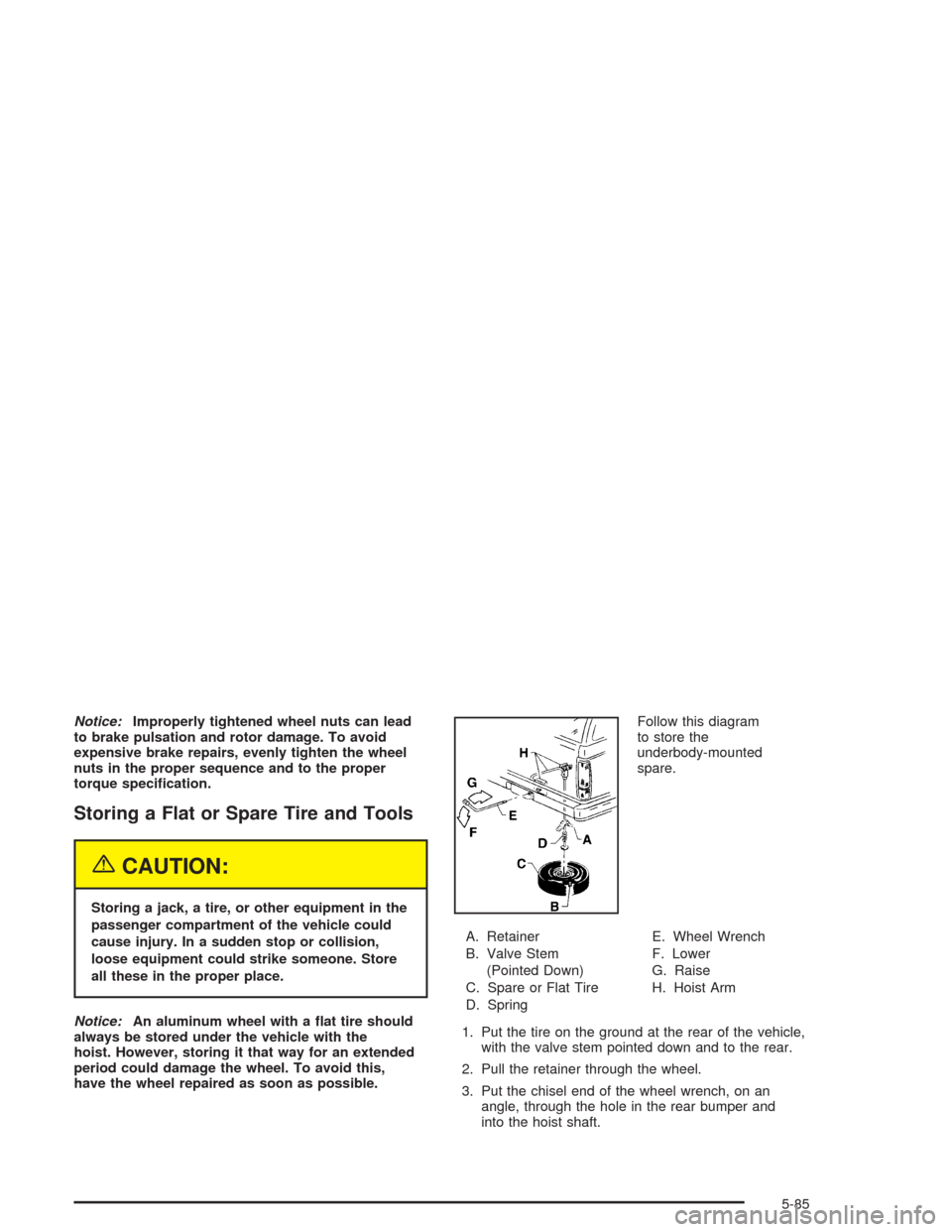
Notice:Improperly tightened wheel nuts can lead
to brake pulsation and rotor damage. To avoid
expensive brake repairs, evenly tighten the wheel
nuts in the proper sequence and to the proper
torque speci�cation.
Storing a Flat or Spare Tire and Tools
{CAUTION:
Storing a jack, a tire, or other equipment in the
passenger compartment of the vehicle could
cause injury. In a sudden stop or collision,
loose equipment could strike someone. Store
all these in the proper place.
Notice:An aluminum wheel with a �at tire should
always be stored under the vehicle with the
hoist. However, storing it that way for an extended
period could damage the wheel. To avoid this,
have the wheel repaired as soon as possible.Follow this diagram
to store the
underbody-mounted
spare.
A. Retainer
B. Valve Stem
(Pointed Down)
C. Spare or Flat Tire
D. SpringE. Wheel Wrench
F. Lower
G. Raise
H. Hoist Arm
1. Put the tire on the ground at the rear of the vehicle,
with the valve stem pointed down and to the rear.
2. Pull the retainer through the wheel.
3. Put the chisel end of the wheel wrench, on an
angle, through the hole in the rear bumper and
into the hoist shaft.
5-85
Page 379 of 446
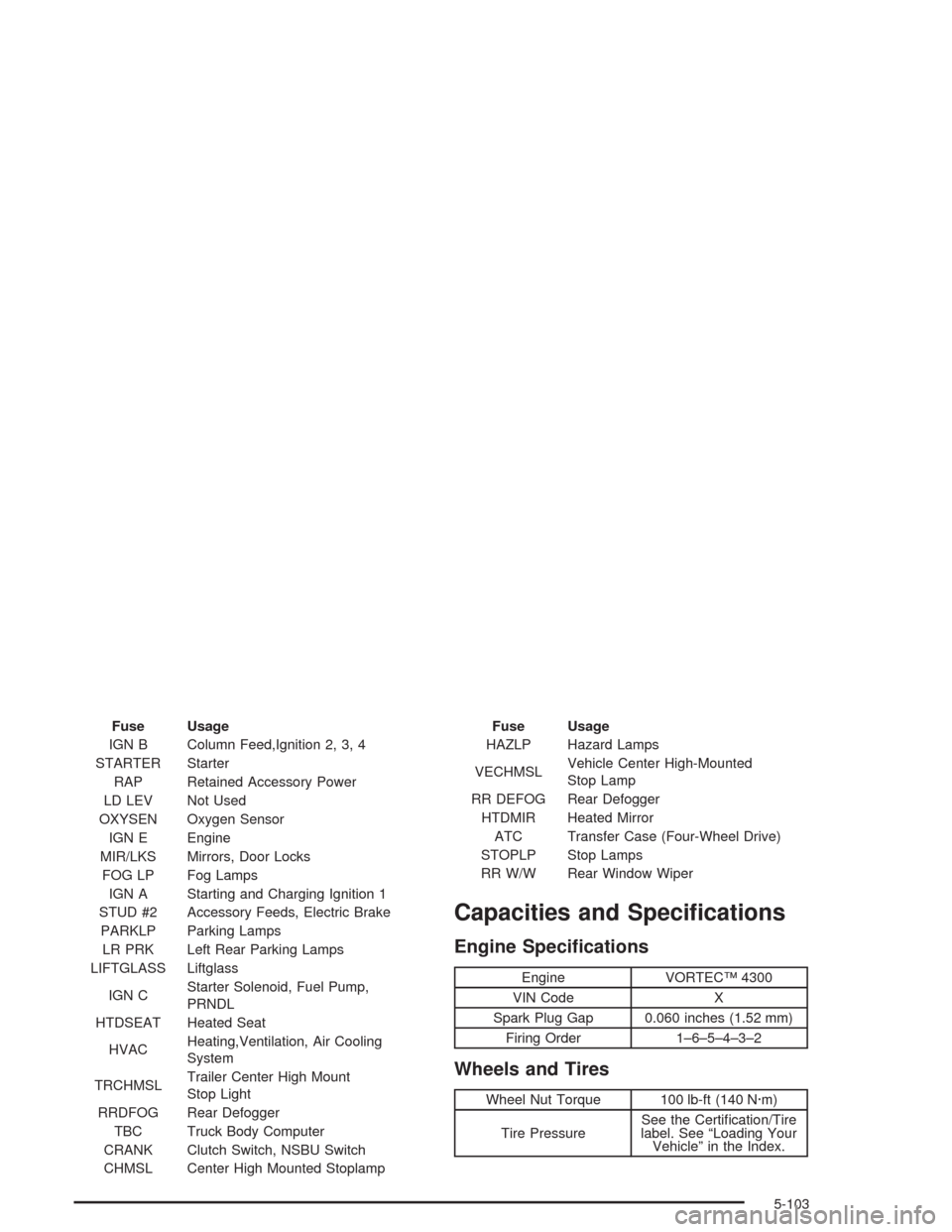
Fuse Usage
IGN B Column Feed,Ignition 2, 3, 4
STARTER Starter
RAP Retained Accessory Power
LD LEV Not Used
OXYSEN Oxygen Sensor
IGN E Engine
MIR/LKS Mirrors, Door Locks
FOG LP Fog Lamps
IGN A Starting and Charging Ignition 1
STUD #2 Accessory Feeds, Electric Brake
PARKLP Parking Lamps
LR PRK Left Rear Parking Lamps
LIFTGLASS Liftglass
IGN CStarter Solenoid, Fuel Pump,
PRNDL
HTDSEAT Heated Seat
HVACHeating,Ventilation, Air Cooling
System
TRCHMSLTrailer Center High Mount
Stop Light
RRDFOG Rear Defogger
TBC Truck Body Computer
CRANK Clutch Switch, NSBU Switch
CHMSL Center High Mounted StoplampFuse Usage
HAZLP Hazard Lamps
VECHMSLVehicle Center High-Mounted
Stop Lamp
RR DEFOG Rear Defogger
HTDMIR Heated Mirror
ATC Transfer Case (Four-Wheel Drive)
STOPLP Stop Lamps
RR W/W Rear Window Wiper
Capacities and Speci�cations
Engine Speci�cations
Engine VORTEC™ 4300
VIN Code X
Spark Plug Gap 0.060 inches (1.52 mm)
Firing Order 1–6–5–4–3–2
Wheels and Tires
Wheel Nut Torque 100 lb-ft (140 N·m)
Tire PressureSee the Certi�cation/Tire
label. See “Loading Your
Vehicle” in the Index.
5-103
Page 444 of 446
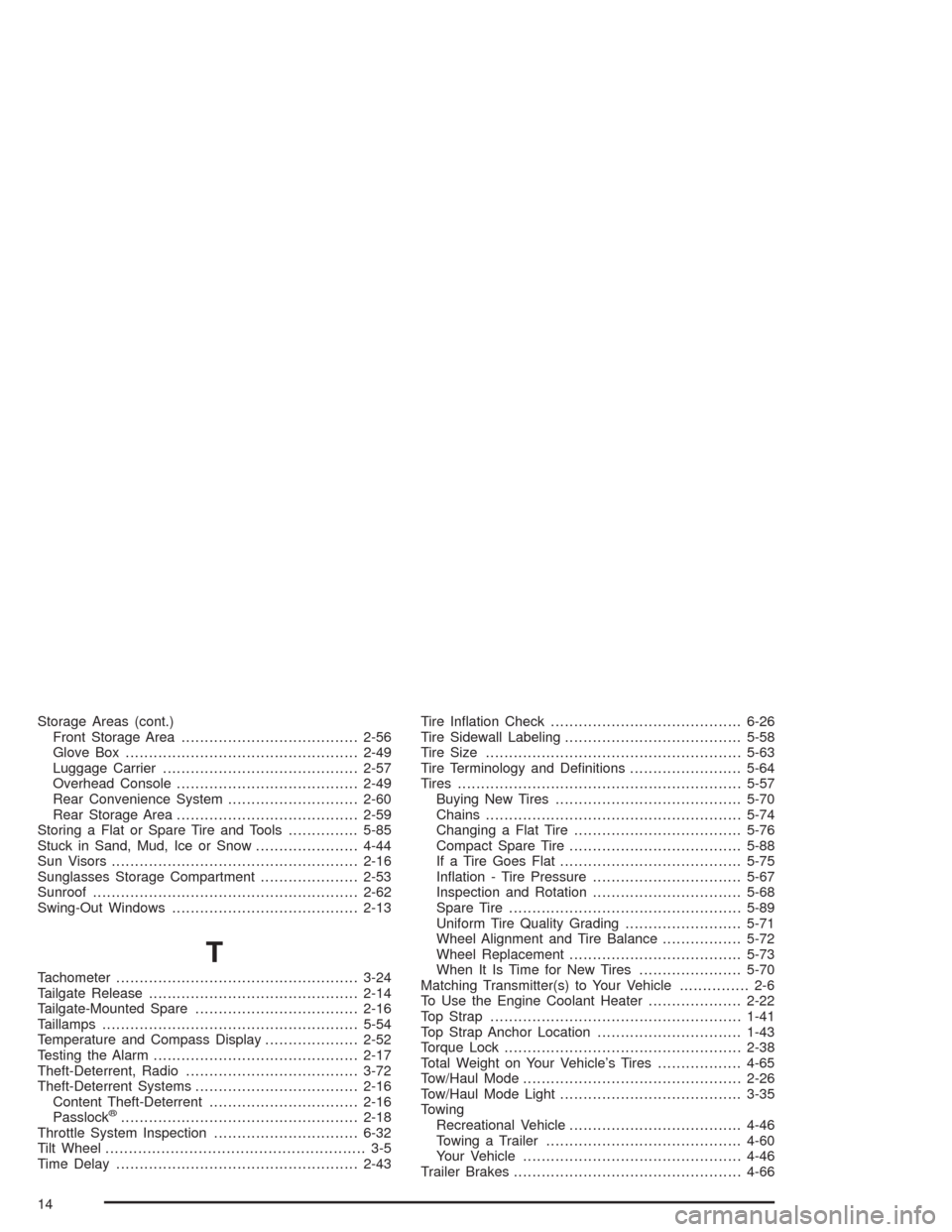
Storage Areas (cont.)
Front Storage Area......................................2-56
Glove Box..................................................2-49
Luggage Carrier..........................................2-57
Overhead Console.......................................2-49
Rear Convenience System............................2-60
Rear Storage Area.......................................2-59
Storing a Flat or Spare Tire and Tools...............5-85
Stuck in Sand, Mud, Ice or Snow......................4-44
Sun Visors.....................................................2-16
Sunglasses Storage Compartment.....................2-53
Sunroof.........................................................2-62
Swing-Out Windows........................................2-13
T
Tachometer....................................................3-24
Tailgate Release.............................................2-14
Tailgate-Mounted Spare...................................2-16
Taillamps.......................................................5-54
Temperature and Compass Display....................2-52
Testing the Alarm............................................2-17
Theft-Deterrent, Radio.....................................3-72
Theft-Deterrent Systems...................................2-16
Content Theft-Deterrent................................2-16
Passlock
®...................................................2-18
Throttle System Inspection...............................6-32
Tilt Wheel........................................................ 3-5
Time Delay....................................................2-43Tire In�ation Check.........................................6-26
Tire Sidewall Labeling......................................5-58
Tire Size.......................................................5-63
Tire Terminology and De�nitions........................5-64
Tires.............................................................5-57
Buying New Tires........................................5-70
Chains.......................................................5-74
Changing a Flat Tire....................................5-76
Compact Spare Tire.....................................5-88
If a Tire Goes Flat.......................................5-75
In�ation - Tire Pressure................................5-67
Inspection and Rotation................................5-68
Spare Tire..................................................5-89
Uniform Tire Quality Grading.........................5-71
Wheel Alignment and Tire Balance.................5-72
Wheel Replacement.....................................5-73
When It Is Time for New Tires......................5-70
Matching Transmitter(s) to Your Vehicle............... 2-6
To Use the Engine Coolant Heater....................2-22
Top Strap......................................................1-41
Top Strap Anchor Location...............................1-43
Torque Lock...................................................2-38
Total Weight on Your Vehicle’s Tires..................4-65
Tow/Haul Mode...............................................2-26
Tow/Haul Mode Light.......................................3-35
Towing
Recreational Vehicle.....................................4-46
Towing a Trailer..........................................4-60
Your Vehicle...............................................4-46
Trailer Brakes.................................................4-66
14